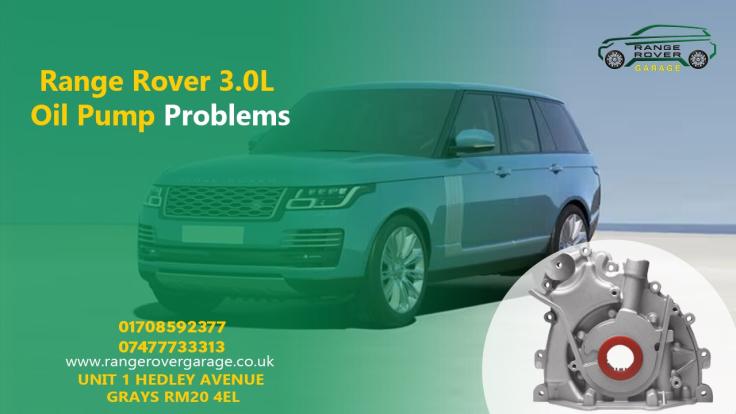Range Rover 3.0L Oil Pump Problems: Signs, Causes and Repair Advice
- Posted on June 16, 2025
- blogs
- By Administrator
- 1553 Views
Most Range rover 3.0L have common oil pump failure problems. In this blog we discuss causes of oil pump failure in 3.0L range rover signs and advice how we repair if we face this issue

If your Range Rover is parked outside and that pesky oil warning light is glaring at you, then you are not alone. Oil pump issues are something many 3.0L Range Rover owners face, but the silver lining? There are fixes out there but with right knowledge and action only.
In this guide, we'll cover what oil pump failure is, why it happens in 3.0L models, how to detect it early, and what you can do about it.
What’s the Role of the Oil Pump and Why Should You Care?
Your engine needs oil to run smoothly. The oil pump circulates oil through the engine to keep the components well-lubricated, reduce friction and prevent overheating.
When the oil pump has problems, the engine misses out on that essential lubrication. It’s like trying to run a marathon race without any water; things can really start to seize up.
For a 3.0L Range Rover, any oil pump failure can lead to serious engine trouble if not caught in time. You could end up with major wear on your camshaft, crankshaft issues, or worse, needing a whole new engine. So, it’s important to pay attention.
What Causes Oil Pump Failures in Range Rover 3.0L?
Oil pumps don’t just break for no reason. For the Range Rover 3.0L, especially the SDV6 and TDV6 models, there are a few common issues:
1. Design Issues
Some of these engines have oil pumps that might not hold up under pressure, especially if you’re towing heavy loads or driving aggressively.
2. Sludge Buildup
If you skip oil changes or use low-grade oil, sludge can build up and block oil channels, forcing the pump to work too hard until it fails.
3. Timing and Crankshaft Problems
For some 3.0L models, timing issues and worn crank pulleys can affect how the oil pump works, especially if you’ve delayed a timing belt or chain replacement.
4. Inconsistent Maintenance
If the car hasn’t been maintained well, there is a higher chance of oil pump wear. Clean oil and regular servicing go a long way.
Warning Signs of Oil Pump Failure in a Range Rover 3.0L
Your Range Rover isn't going to outright say, “I need a new oil pump!” but it will give you some signs to look for. Keep an eye out for these:
1. Low Oil Pressure Warning Light
This is the big one. If this light comes on, stop driving right away and have it checked.
2. Knocking or Tapping Sounds
If your engine starts making unusual sounds, especially from the top, it could mean it’s not getting enough oil.
3. Engine Overheating
Low oil pressure can lead to overheating. If the temperature gauge is rising and the oil light is on, that’s a serious warning.
4. Burning Oil Smell
If you smell something burning, it might be oil overheating on the engine parts due to lack of lubrication.
5. Poor Engine Performance
If your Range Rover feels sluggish or hard to start or the engine is not performing well, it could be a sign of trouble caused by poor oil flow.
Is it Safe to Drive with an Oil Pump Failure?
In short: No, it's not!
Driving with a faulty oil pump leads to engine destruction. If you suspect something is wrong, stop driving and get it checked out as soon as possible.
Acting quickly can save you a lot of hassle and money.
Cost Estimate for Repairing or Replacing a Range Rover 3.0L Oil Pump
Here’s the breakdown. Depending on the issue, you might be looking at:
Diagnostic check: £60–£120
Oil pump replacement (labour and parts): £800–£1,500
Extra engine repairs (if needed): £2,000–£6,000+
Full engine rebuild or replacement: £4,000–£8,000
If the oil pump fails while the engine is still running, damage can be extensive. In some cases, replacing the engine might be necessary.
Which One to Choose: Repair, Rebuild or Replace?
So, what should be your next move if your Range Rover 3.0L is having failure? Here are your choices:
1. Replace the Oil Pump
If everything else is in good shape, swapping out the oil pump could get you back to normal without too much fuss.
2. Engine Rebuild
If there's already damage to things like the camshaft, crankshaft or bearings, you might need to rebuild the engine. It can be costly, but it often gives the engine a fresh start.
3. Engine Replacement
If the damage is catastrophic, a used or reconditioned engine is more cost effective rather than rebuilding.
How to Prevent Future Oil Pump Issues
Want to avoid problems down the road? Keep these tips in mind:
● Use quality: oil that meets Land Rover specs (usually 5W-30 or 5W-40 for diesels).
● Change oil and filters regularly: even more frequently for older models.
● Don’t ignore warning lights: They’re there for a reason.
● Follow the timing belt or chain schedule: it is linked to the oil pump functions in some cars.
● Check oil pressure routinely: if you feel a drop in performance or have high mileage.
● Invest in diagnostics: if something seems off. Early detection can save headaches.
Is This a Recall Situation or Just Bad Luck?
As of now, there is not a widespread recall for oil pump failures in 3.0L Range Rovers, but it’s been talked about in various car forums. If your vehicle is still under warranty or has an extended service plan, check with Land Rover or a Range Rover specialist.
Who Should You Trust with the Repair?
Not every mechanic is equipped to deal with Range Rover engines, especially with oil pressure and timing involved. Stick with a Land Rover specialist or a trusted engine repair shop that knows their stuff with 3.0L engines.
Look for:
● Diagnostic tools
● Experience with oil pump work
● Clear pricing
● Warranty on repairs
You definitely don’t want to go cheap on this type of repair.
Conclusion: Catch Oil Pump Failure Early, Save Your Engine
Oil pump failure in a Range Rover 3.0L isn't just a hassle; it can lead to serious damage if not addressed. By staying alert to the signs, getting smart diagnostics, and acting quickly, you can avoid major damages.
If your Range Rover is acting strange or that oil light is on, book it in for an inspection soon. A little investment now could save you a lot later.
FAQs
Q: How long does it take to replace a 3.0L oil pump?
A: Depending on engine access and any extra damage, generally, plan for about 1–2 days.
Q: Can an oil change fix a bad oil pump?
A: No, a bad oil pump needs to be replaced. But changing oil regularly can help prevent future issues.
Q: Can I replace the oil pump myself?
A: It’s good if you’re skilled with engines, but this job needs access to the engine, proper torque settings and timing experience. Most people would do better with a specialist.
Q: Is oil pump failure covered under warranty?
A: If your vehicle is under warranty or has an extended plan, it might be. Always check your policy details.
Q: Is it safe to drive with a faulty oil pressure sensor instead of a failing pump?
A: It could be okay, but only after confirming it’s the sensor and not the pump. Don’t guess; get it checked before driving.

